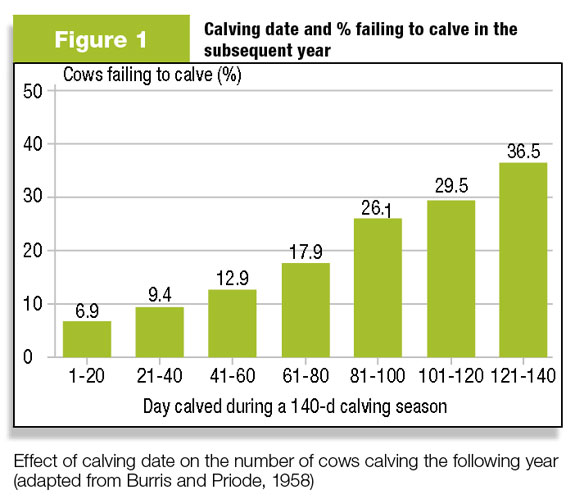However, longevity is one of the most important traits for the economic sustainability of beef cattle producers. It is also one of the most difficult traits to select for because it is affected by so many external factors.
Several breed EPDs are trying to get a handle on stayability, which is great, but because the reasons for a cow leaving the herd prematurely are so abundant, it is difficult to develop accurate predictions.
There are several reasons and traits that will influence longevity in beef cows, including age at puberty, direct and maternal calving ease, milk production, mature size, fleshing ability, ability to endure extreme weather, udder soundness, skeletal soundness, genetic defects and many other reasons.
It has been estimated that a cow must reach 6 years old and have reared four calves before she has paid for her developmental costs.
The optimal economic return for cows has been reported to be within the range of 8 to 11 years old for commercial cow-calf operations.
However, research has reported that less than 30 percent of cows within a herd reach 10 years old. A lot of time and money are put towards developing heifers.
Generally speaking, it is not that difficult to get heifers in good enough condition to breed as yearlings. Getting her to rebreed as a first-calf heifer is the much bigger challenge.
The first-calf heifer is usually considered the most difficult to manage and re-breed due to her lactation requirements in addition to her growth requirements.
Why then do cows fall out of the herd in their productive primes after they have overcome the hurdles of getting re-bred as still-growing 2-year-old and 3-year-old cows?
Certainly heifer developmental programs and environmental factors play a role. However, we want to focus on another potential factor.

The answer, in part, may possibly be explained by Figure 1. Although the data is from the 1950s, it is more pertinent now than ever.
This graph illustrates that cows that calve later in the calving season are more likely to fall out of the herd.
Although this seems simplistic, it is directly related to how early in the breeding season cows are being bred.
Cows that fall out of the breeding season in their prime years, 4 to 6 years old, likely were pushed back a little every year.
If detailed records were kept, it could be noted that each year a cow may move back a little more and after a few years she is calving late and simply does not have enough time to resume cycling before the bulls are pulled.
Physiologically there is likely nothing wrong with that cow – she simply did not have enough time to re-breed.
Viable options to combat this in commercial cowherds are to synchronize with a progestin-based protocol.
The progesterone will help initiate resumption of estrous in cows that are just on the edge of resuming cyclicity.
Although many producers assume that synchronization protocols are limited to herds that utilize artificial insemination, work out of the University of Nebraska has detailed how synchronizing mature cows and utilizing natural service can be tremendously beneficial.
Furthermore, research from the University of Nebraska demonstrates on 10 years’ worth of data that heifer calves born during the first 21 days of the calving season are heavier at weaning than their contemporaries born later in the calving season.
One of the greatest determining factors that will dictate how early and well heifers will breed is pubertal status entering the breeding season.
In the evaluation, 70 percent of the early-born heifers (born first 21 days of calving season) were cycling, or had reached puberty, prior to the breeding season, compared with heifers born after day 21 (58 percent cycling) or after days 43 (39 percent cycling) in the calving season, which resulted in a significantly greater overall pregnancy rate for early born heifers compared with heifers born after day 43 (90 percent vs. 78 percent, respectively).
Additionally, there is a strong relationship between the age of puberty in heifers and their lifelong postpartum interval (the period of time between calving and when they begin cycling).
Therefore, the more cows that are bred early in the breeding season can lead to earlier-maturing heifers, greater pregnancy rates in those heifers and increased chances of those cows continuing to breed earlier in the breeding season and remaining in the herd.
Although selecting specifically for longevity has its challenges and limitations, managing cows to breed earlier in the breeding season can have lifelong implications for replacement heifer calves and may increase their stayability and hopefully your profitability. ![]()








